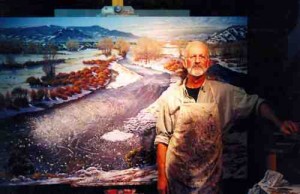Review by Ed Quillen
Railroads – September 2003 – Colorado Central Magazine
Workin’ on the Railroad – Reminiscences from the Age of Steam
Edited by Richard Reinhardt
Originally published in 1970
Republished in 2003 by Red River Books, University of Oklahoma Press
ISBN 0-8061-3525-5
IF YOU LIKE RAILROAD LORE, you’ll love this book. It’s an anthology of tales told by railroaders — from machinists and telegraphers and gandy dancers to brakemen, engineers, firemen and conductors. Other stories come from hoboes, residents of railroad towns, railway mail sorters, newsboys, surveyors; the vast range of people involved with railroading in the old days demonstrates how central they once were to American life and culture.
As the subtitle indicates, Workin’ on the Railroad covers the industry from the first American steam locomotive, the Stowbridge Lion, which first steamed on Aug. 8, 1829, to the first diesel locomotives, which went into service in 1934.
Editor Robert Reinhardt combed old magazines and newspapers for rail-related reminiscences, which he then assembled into this book, along with some connective commentary.
He had a good eye. All these tales are quite readable, though some might require consulting the glossary in the back, since terms like “drawhead,” “petcock” and “hawkshaw” are no longer in common use.
This is a national collection, so it doesn’t focus on Colorado, let alone Central Colorado. But our part of the world is represented, probably more than the local mileage would justify; this area produced plenty of lore, on account of its steep grades, winding routes, and winter snows.
The chapter about railroad towns, for instance, has an account from a travel writer who visited the end of the track for the growing Denver & Rio Grande in 1882. That was Cimarron, where the rails climbed out of the Black Canyon of the Gunnison (and where the National Park Service has an exhibit today, including a narrow-gauge train). Here’s how Ripley Hitchcock described it:
“I stopped at the boarding train, which stood opposite a rock tower a thousand feet in height. The sunlight fell upon its pinnacle, gilding a huge profile carved by nature, but the canyon depths were all in shadow. Here was the temporary home of four hundred men….
“Presently a whistle blew. Six o’clock had come, and the men, leaving their tasks, scrambled aboard the flatcars, and the train rumbled back to the ‘Hotel on Wheels.’ Long before the car stopped, the men were hustling each other like a flock of stampeded sheep in a wild race for supper…”
They were “men of a score of nationalities, begrimed, tattered, gnawed at by the appetite given by labor in the bracing Colorado air… On the table were tin pannikins, iron knives and forks, and pewter spoons. Mounds of coarse bread, pans of some strange stew, and pots of rank black tea appeared and disappeared. Words were not wasted. Every act had a bearing upon the business of satisfying hunger….
“It was a glimpse of a hard, cheerless life that I had seen, but as I turned back to the construction train, someone struck up a rollicking Irish song, and others joined until the canyon walls gave back the chorus.”
Some of the tales come from Cy Warman, and he is mentioned often in the connective material. Warman may be best known in Colorado as the editor who penned the lines “It’s day all day in the daytime, and there is no night in Creede,” and elsewhere in America he’s probably best known as the author of the lyrics for “Sweet Marie.”
Warman had close connections to Central Colorado, and Reinhardt points out that Warman was the leading railroad writer — as a journalist, essayist, poet, and novelist — in America at the start of the 20th century.
Warman, who had little formal education, was born in Illinois in 1855, and arrived in Colorado in 1880, where he worked at a smelter near Canon City. He soon got on with the Denver & Rio Grande; by 1883 he was an engineer, driving the locomotive on what he called “the Perpendicular Run” between Salida and Leadville. He also managed to get some poems published in a Salida newspaper, so he turned to full-time writing.
He failed at a couple of publications in Denver, wrote for the Rocky Mountain News for a few months, then in 1892 founded a Creede newspaper — which also failed, but not before the New York Sun picked up Warman’s work and gave him a national audience. He was a prolific writer until his death in 1914 — and his career started in Salida and blossomed in Creede.
Back to Workin’ on the Railroad: It’s a lively and extensive anthology that will delight any railroad buff.
— Ed Quillen

